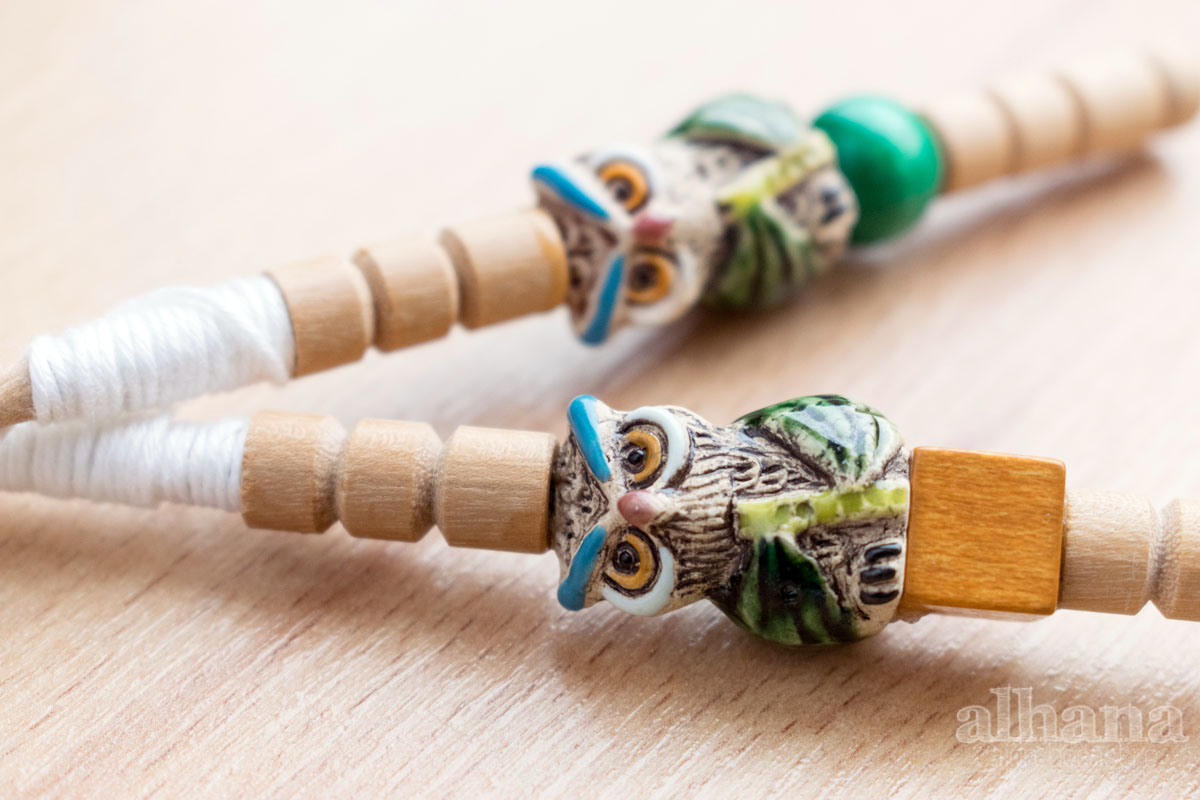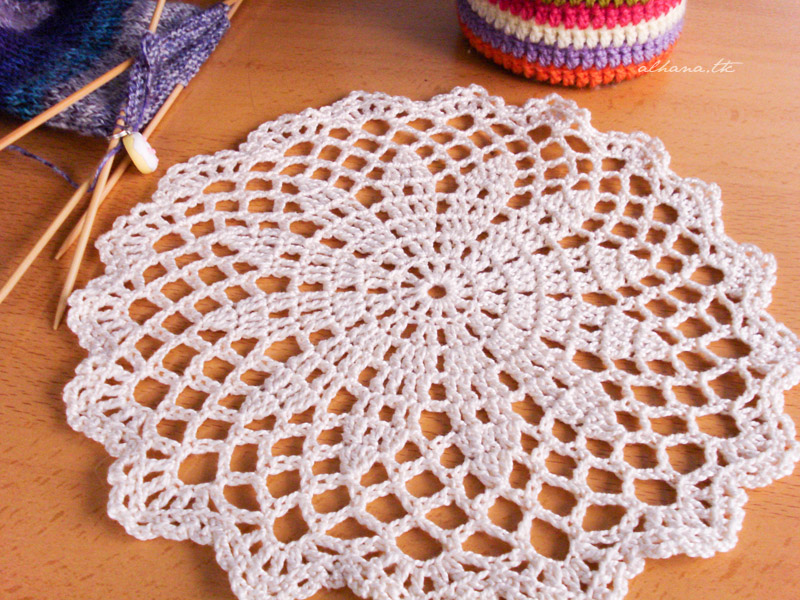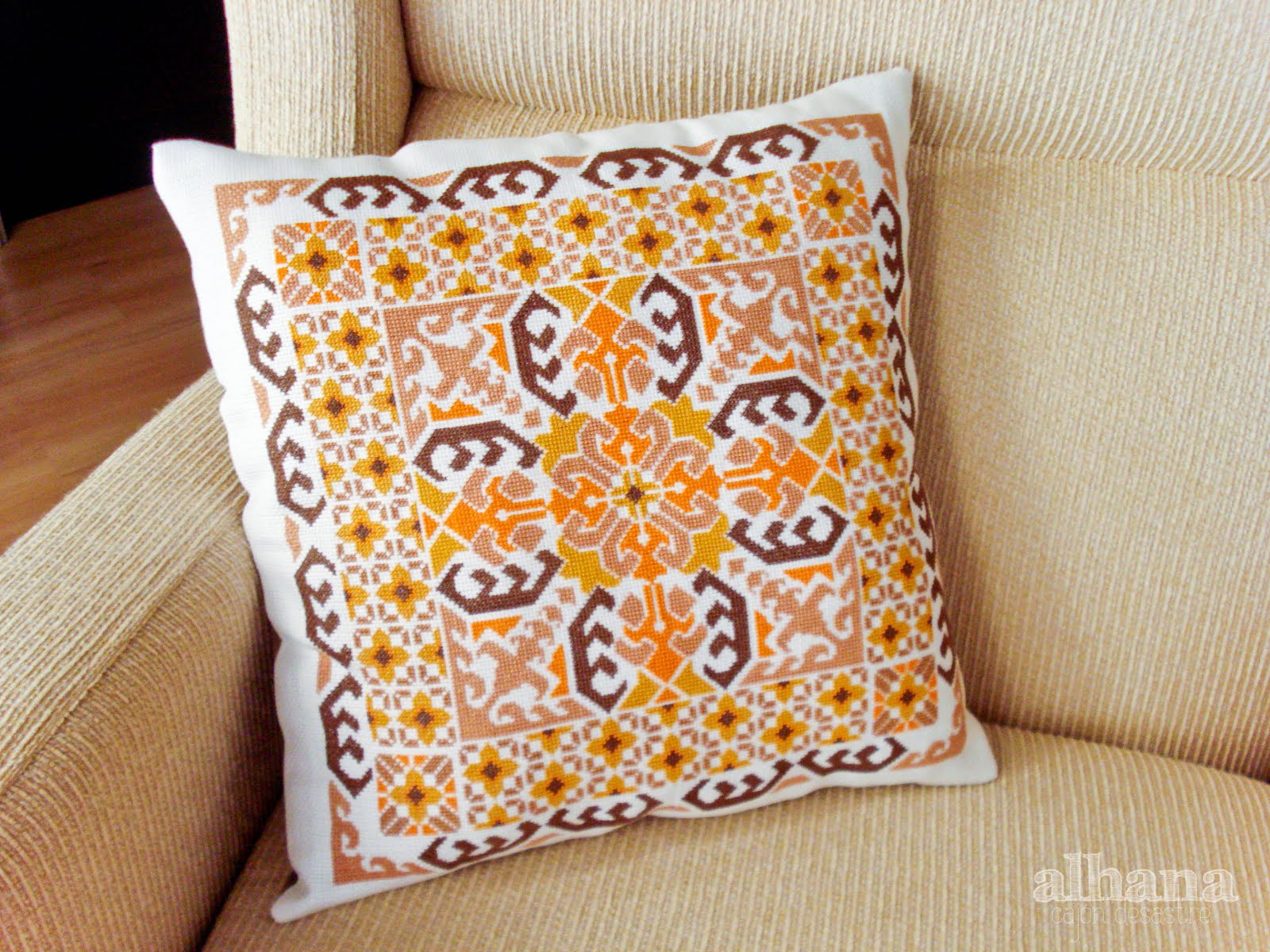 |
| Pirum Parum |
→ English
Una de las cosas maravillosas de Internet es poder contactar con personas que de otro modo jamás podrías conocer y trabar amistad con ellas. Conocí a Aki en Instagram y me enamoré al instante de la delicadeza y serenidad de sus fotografías. En un viaje reciente a Japón tuvo el detalle de mandarme unas postales Gotōchi (regionales), para mi deleite —¡hace años que soñaba con tener una!—, y una funda para guardar la correspondencia.
Para agradecérselo, decidí tejerle algo bonito. Desde el principio tuve claro que sería un amigurumi —ya iba siendo hora de tejer otro— que le hiciera compañía a Aki mientras escribe sus diarios pero, ¿cuál? Estuve dudando entre varios modelos sin decidirme por ninguno hasta que al final recordé la simpática perita que el año pasado inundó los blogs y redes sociales.
 |
| ¿Por qué estás tan seria, Pirum? |
¡Dicho y hecho! Me costó más hacerme con el patrón que tejer a Pirum. Se teje en un día y no presenta más problemas que insertar los ojos (es un problema cuando no tienes ningún aparato con el que ayudarte) y bordar la cara. Como yo puse los ojos a mano y no tenía experiencia en bordar hocicos, tardé dos días en vez de uno, ensayando y probando, hasta dar con la expresión que tenía en mente.
 |
| Ojos, hocico y coloretes |
También tejí varios coloretes con diferentes hilos y ganchillos hasta conseguir el tamaño adecuado. El patrón indica que el cuerpo se ha de tejer con hebra doble y los coloretes con hebra sencilla, usando ambos la misma calidad de hilo. No fue así en mi caso, ya que quería un amigurumi más pequeño. Tejí el cuerpo con hebra sencilla y recurrí a un hilo de algodón mercerizado fino para crear unos mofletes proporcionales a mi Pirum.
 |
| Tallo y hoja |
Como ya se ha hablado largo y tendido sobre este libro desde su publicación no haré otra reseña pero sí añadiré mi experiencia personal sobre este patrón en concreto:
- Las instrucciones están escritas tal y como suele ser habitual en los patrones de habla inglesa, esto es, sin esquema gráfico. Acostumbrada como estoy a los patrones clásicos de revistas españolas y japonesas, me ha resultado un poco extraño tejer siguiendo un texto sin poder visualizar de antemano lo que voy a hacer.
- Vienen acompañadas de unas pocas fotografías y, aunque sí indica ciertos detalles tales como en qué momento insertar los ojos o empezar a rellenar, no explica cómo insertar el tallo y la hoja. ¡Me volví loca para averiguarlo porque quería que el resultado fuese perfecto! Los consejos de 5 Little Monsters en su patrón de manzana me vinieron de perlas.
- Tampoco explica cómo bordar el hocico, sino que se han de tomar las fotografías como modelo. De nuevo recurrí a un tutorial para conseguir un acabado perfecto:
 |
| Cómo bordar hocicos |
Y, sin más dilación, pasamos a los detalles técnicos del proyecto antes de que me enrolle más, que siempre sé cuándo empiezo pero nunca cuándo acabo:
Pirum Parum
Lana: Katia Monaco en rosa (11) y fucsia (13), 100% algodón. Para el tallo, un resto acrílico en color beige.
Ganchillo: 3.0 mm para el cuerpo, tallo y hoja; 2.0mm para los coloretes.
Tamaño: 11 cm de alto, 15 cm con el tallo incluído, y 8 cm de diámetro.
Patrón: Pirum Parum de Sandrine Deveze, incluído en el libro Tendre Crochet (disponible en español).
Otros: un par de ojos de plástico negro de bola de 6mm con cierre de seguridad.
Por último, no me gustaría despedirme sin enseñaros una de las fotos del escritorio de Aki en las que aparece Pirum y desde aquí agradecerle una vez más su permiso para compartir esta imagen y su amabilidad al acordarse de mí durante su viaje. ¡Muchísimas gracias! Si os gusta el tema de diarios y papelería (¿a quién no?) y queréis disfrutar de su preciosa caligrafía podéis ver más en su cuenta de Instagram.
¡Feliz mes de septiembre!
Muchas gracias por leerme.
Hasta la próxima.
♥
 |
| Pirum Parum |
→ Español
One of the best things of the Internet is getting acquainted to people you wouldn't be able to meet otherwise. I met Aki on Instagram and instantly fell in love with her peaceful and feminine style. She was kind enough to send me a few Gotōchi (regional) postcards from her recent trip to Japan along with a cute plastic case to store them. I had been dreaming with these postcards for years!
As a thank-you gift I decided to craft something cute. It had to be an amigurumi —it was about time to crochet one— that would keep her company while she writes on her journals. But which one? They are so many and all of them are pretty! I couldn't decide on a pattern until I remembered the sweet little pear that flooded blogs and social media last year.
 |
| Why so serious, Pirum? |
No sooner said than done! Getting the pattern was harder than crocheting Pirum. You can made it in just one day and the most difficult part is attaching the safety eyes, which is burdersome when you don't have any tool for that, and embroidering the snout. I attached the eyes by hand and had zero experience embroidering noses so it took me an extra day until I got the face expression I had in mind by trial and error.
 |
| Eyes, snout and cheeks |
I also crocheted several cheeks with different yarn and hooks to achieve the desired size. Pattern says to crochet the body with double thread while cheeks use single thread from the same yarn. Since I wanted a smaller amigurumi, I used single thread for the body and thus I had to crochet the cheeks with a thin mercersided cotton thread to get proportional cheeks.
 |
| Stem and leaf |
Much has been said about this book since it was first published so I will not be writing another review. However, I will talk a bit about my personal experience with this pattern:
- Instructions are written and do not include a graphic chart, as it is customary for English patterns. I am used to Spanish and Japanese magazines where they use charts instead of words and feel a bit lost crocheting without visualising beforehand what I am doing.
- It includes a few photos and although it does explain when to insert the eyes and start stuffing the toy there is no explanation on how to attach the stem and the leaf. I went crazy looking for advice online because I wanted a perfect result! 5 Little Monsters tips for her apple pattern came in handy here.
- It also doesn't explain how to embroider the snout, just tells you to observe the pictures and try to copy them. Again I resorted to an online tutorial to achieve a perfect finish touch:
 |
| How to embroider the snout |
Now, without further delay let us see the project details —I tend to blabber too much, I know:
Pirum Parum
Yarn: 100% cotton pink (11) and dark pink (13) Katia Monaco. Beige acrylic leftover for the stem.
Hook: 3.0 mm for body, stem and leaf; 2.0mm for cheeks.
Size: 11 cm / 4 ⅓" tall, 15 cm / 6" including stem, and 8 cm / 3 ¼" wide.
Pattern: Pirum Parum by Sandrine Deveze, included in the book Tendre Crochet (available in English).
Notions: a pair of black plastic 6mm ball safety eyes.
Last but not least, before saying good-bye I would like to show you a picture of Aki's desk featuring Pirum and thank her once again for giving me permission to share this photo with you and for her kindness thinking of me during her trip. Thank you very much! If you like journaling and stationery (who doesn't?) and want to soak in her beautiful handwriting you can see more at her Instagram feed.
Happy September everyone!
Thanks for reading.
See you next time.
♥









Oh my, super cute pear!! Visiting from Cooking and Crafting with JJ party.
ReplyDeleteThank you very much for your visit and your kind comments, Victoria. You're welcome! :-)
DeleteWell.. I think Aki has got a dreamy companion wile he writes his diaries and it couldn't be an cuter! A wonderful gift to celebrate friendship!
ReplyDeleteThank you, Maya! I loved crocheting this little guy and will make a matching companion for me too. ;-)
DeleteHave a wonderful week!
¡Me encanta! Has conseguido una expresión muy bonita. Un beso.
ReplyDelete¡Muchas gracias, Ana María! No paré hasta conseguir la expresión que tenía en mente. :-)
DeleteUn beso.
Es una cucada!! me encanta!
ReplyDelete¡Gracias! Es una perada, ¿o no? ;-)
DeleteHello Alhana, oh I love this pink purim that you made. It is adorable and I know your friend will love it!
ReplyDeleteThanks for sharing this at Cooking and Crafting with J & J!!
Thank you very much, Julie. It's always a pleasure to contribute to your link party!
DeleteHave a nice day.
How cute!!!
ReplyDeleteThanks, Libby! I'm glad you liked it. ♥
DeleteConfieso que es uno de mis proyectos pendientes, pero siempre, siempre, siempre me la imaginaba verde (ya sé. No soy muy original en cuánto a elección de colores para los amigurumis, jajaja). Pues en rosa es absolutamente adorableeee, con su hoja en fucsia que me tiene enamorada. Y la caja, con el fondo del mismo color... ¡Si es que estás en too! Los patrones de ese libro son muy monos, pero con ciertas explicaciones bastante escasas, (tienes que volverte loca mirando las fotos, para intentar descifrar cómo bordar). Para poner los ojos yo utilizo un sacabocados (lo tenía para hacer agujeros en mis cinturones, y mira por dónde... ¡dándole una nueva vida!). Este tutorial te enseña cómo usarlo. Un besoteeeee. P.D. Me encanta el nuevo aspecto de tu blog. Muuuuuuuuuu profesional y responsive :P.
ReplyDelete¡Gracias, Dácil! Verde quedaría monísima, casi tanto como mi blog responsive y profesional, jajaja. ;-) Lo cierto es que creía recordar que era una pera rosa hasta que me puse a buscar fotos y vi que la original era gris. ¿De dónde me saqué ese rosa? Lo de la caja fue pura casualidad, pero quedó un conjunto que ni pintado. Tomo nota del sacabodados y del tutorial, a ver si a me animo a tejer más amigurumis con todas las facilidades que me das. ;-)
Delete¡Un besote!
Como me gusta Pirum!
ReplyDeleteEn rosa te quedó genial!!
Y es verdad que el libro viene con pocos detalles de cosas fundamentales… pero lo has solucionado estupendamente!
Besos
¡Muchas gracias, Ana! Pirum rosa está muy cuca, ¿verdad? Lo cierto es que la veía gris en las fotos, pero en mi mente claramente era rosa. ;-) El patrón está muy bien escrito, sin embargo para los que no estamos acostumbrados a tejer amigurumis estos detallitos suponen una gran ayuda.
DeleteBesos.